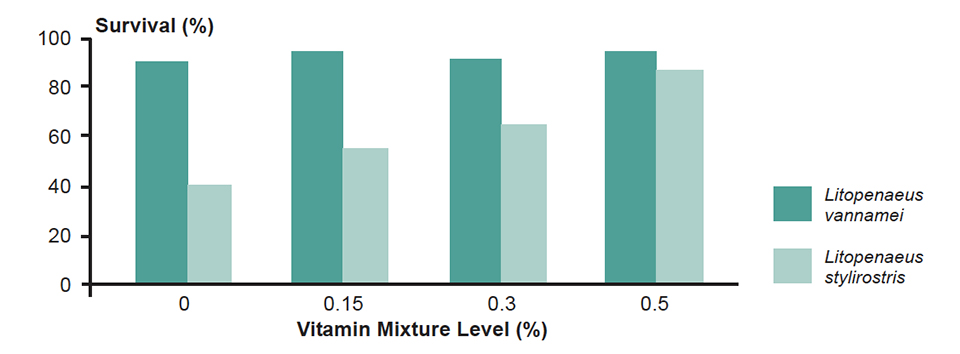In trials, L. vannamei tolerated complete withdrawal of supplemental vitamins
Feed is generally the most expensive operating cost of a shrimp farm, and vitamins are generally the most expensive micronutrient added to the feed. Yet, information on quantitative vitamin requirements of shrimp is very limited. Only a few studies have been conducted with a few species. Shrimp require vitamins in trace amounts for maintenance metabolism and growth. Most vitamins are either not synthesized by shrimp or synthesized at an insufficient rate for maximum growth. Thus, shrimp have to obtain vitamins from exogenous sources. Inclusion of vitamins in feed formulations, sometimes in excess to avoid possible dietary deficiencies, is common practice.
Minimum vitamin levels
In order to reduce the inclusion of vitamins in shrimp diets, it is necessary to determine minimum vitamin levels that do not reduce survival and growth. Recent studies have suggested that vitamin intake from feed ingredients – and most likely from plant (phytoplankton) and animal (crustaceans, copepods, polychaetes, nematodes, and chironomid larvae) pond organisms – is sufficient for shrimp biomass gain. Bacteria also have been implicated as an important source of nutrients. Recently, laboratory feeding trials were used to evaluate diets with different vitamin levels in systems without natural productivity, other than bacteria.
Experimental trials at Texas A&M University
A series of 21-day experimental trials were conducted at the Shrimp Mariculture Research facility, Texas A&M University, to test the ability of shrimp to utilize bacteria to satisfy their requirements for vitamins. Postlarval L. vannamei and L. stylirostris (2 and 1.3 mean initial weight, respectively) were stocked at a density of 1.5 postlarvae (PLs) per liter and 0.75 PLs per liter, respectively, in a system without water exchange and with constant aeration.
Water temperature was maintained between 28 and 30 degrees-C and salinity was maintained between 23 and 25 ppt for L. vannamei and between 20 and 23 ppt for L. stylirostris. Ammonia-N and nitrite-N were measured at the end of the trial.
Four semi-purified diets containing vitamin mixture levels of 0, .15, .30 and .50 percent were evaluated using a completely randomized design with nine replicates per treatment. The .50 percent vitamin mixture level was proven by us and other researchers to satisfy shrimp requirements for good survival and growth under clean water conditions. Thus, levels below .50 percent were tested.
Results
For L. vannamei, mean PL survival was > 91 percent for all treatments (Fig. 1), and survival and growth were not significantly affected by vitamin mixture level. Feed conversion ratios ranged between 1.3 and 1.2. Mean concentrations of total ammonia-nitrogen and nitrite-nitrogen were 1.0 (pH = 8.0) and 1.7 milligrams per liter, respectively.

For L. stylirostris, mean PL survival ranged from 41.5 to 84.4 percent and was significantly lower for diets containing .0 and .15 percent vitamin mixture compared to the diet containing .5 percent. Mean PL growth was not significantly affected by vitamin mixture level. However, similar weight gains of PLs among these treatments might have been due to PLs obtaining vitamins by cannibalizing other animals. Feed conversion ratios ranged between 3.0 and 1.2. Mean concentrations of total ammonia- nitrogen and nitrite-nitrogen were .6 (pH = 8.1) and .4 milligrams per liter, respectively.
These results may indicate that:
- L. stylirostris is not as efficient as L. vannamei in utilizing bacteria as a supplier of vitamins.
- The rate of vitamin loss may be higher for L. stylirostris than for L. vannamei.
- The bacterial concentration in the culture tanks of L. stylirostris was not high enough to be ingested in sufficient quantities as to cause a positive effect as suggested by some researchers. Further testing is recommended with longer feeding trials and analysis of vitamin levels in feed, shrimp tissue, and water.
Conclusion
Shrimp feeding trials with graded levels of vitamins were conducted in laboratory tanks without water exchange and without natural productivity, other than bacteria. Results after 21 days indicate that L. vannamei tolerated complete withdrawal of supplemental vitamins, while L. stylirostris suffered reduced survival at low levels of vitamin supplementation. Further testing is recommended to evaluate shrimp vitamin requirements in systems without water exchange, where nutrient recycling within the system may serve to reduce feed cost.
(Editor’s Note: This article was originally published in the August 2000 print edition of the Global Aquaculture Advocate.)
Now that you've finished reading the article ...
… we hope you’ll consider supporting our mission to document the evolution of the global aquaculture industry and share our vast network of contributors’ expansive knowledge every week.
By becoming a Global Seafood Alliance member, you’re ensuring that all of the pre-competitive work we do through member benefits, resources and events can continue. Individual membership costs just $50 a year. GSA individual and corporate members receive complimentary access to a series of GOAL virtual events beginning in April. Join now.
Not a GSA member? Join us.
Authors
-
Mario Velasco, Ph.D.
Director of Nutrition and Research
Empacadora Nacional
Guayaquil, Ecuador -
Addison Lawrence, Ph.D.
Project Leader
Shrimp Mariculture Research
Port Aransas, Texas 78373 USA
Tagged With
Related Posts

Health & Welfare
A holistic management approach to EMS
Early Mortality Syndrome has devastated farmed shrimp in Asia and Latin America. With better understanding of the pathogen and the development and improvement of novel strategies, shrimp farmers are now able to better manage the disease.

Aquafeeds
A look at India’s fish feed industry
India's fish-farming industry makes limited use of modern feeds, providing potential for the feed sector to grow. Commercial feeds are predominantly used for pangasius farming, followed by a rising popularity in carp culture.

Responsibility
A review of water quality improvement products
Prof. Boyd examines products used by aquafarmers to improve water quality and conditions in their ponds and discusses their efficacy.

Aquafeeds
ASAIM addresses challenges to growth of marine fish farming in Southeast Asia
In its efforts to advance sustainable aquaculture practices and the use of soy-based feeds in Southeast Asia, the American Soybean Association International Marketing Program (USAIM) has identified several challenges.


